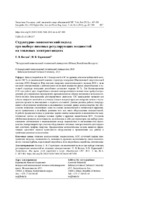Структурно-экономический подход при выборе пиковых регулирующих мощностей на тепловых электростанциях

Date
2023Publisher
Another Title
Structural and Economic Approach to the Selection of Peak Regulating Capacities at Thermal Power Plants
Bibliographic entry
Богдан, Е. В. Структурно-экономический подход при выборе пиковых регулирующих мощностей на тепловых электростанциях = Structural and Economic Approach to the Selection of Peak Regulating Capacities at Thermal Power Plants / Е. В. Богдан, Н. Б. Карницкий // Известия высших учебных заведений и энергетических объединений СНГ. Энергетика. – 2023. – № 6. – С. 497-508.
Abstract
Выход энергоблока № 2 Белорусской АЭС на уровень освоения нейтронной мощности 100 % от номинальной изменил структуру генерации Объединенной энергетической системы (ОЭС) Беларуси. При текущих нагрузках межотопительного периода 2023 г. доля атомной электростанции с работающими на полной мощности двумя энергоблоками в суточной структуре генерации республики составляет порядка 50 %. Для балансирования ОЭС при работе двух энергоблоков атомной электростанции в ночные часы требуется применение регулировочных мероприятий, превышающих по объему имеющиеся возможности. Почти полное использование регулировочного диапазона ТЭС вынужденно приведет все в более широких масштабах к останову блоков на время провалов нагрузки ночью с последующим пуском из неостывшего и горячего состояний. Данные режимы работы генерирующего оборудования неизбежны в сложившихся условиях рынка электроэнергии, что обусловило появление сложнейших задач по оценке экономической и технической эффективности привлечения к подобным режимам того или иного оборудования электростанций. В работе предложен подход к решению задачи синтеза надежности и экономичности энергетических систем на примере газовых турбин и крупных энергоблоков ПГУ. Получена обобщенная функция желательности, включающая в себя ряд параметров для выбора рационального соотношения и взаимовлияния между надежностью и экономичностью производства электроэнергии при участии оборудования тепловых электростанций в регулировании суточного графика нагрузок. Предложенная математическая модель является эффективным средством анализа пригодности оборудования к привлечению для работы в требуемых режимах эксплуатации.
Abstract in another language
The output of power unit No 2 of the Belarusian NPP to the level of neutron power development of 100 % of the nominal level has changed the structure of generation of the Unified Energy System (UES) of Belarus. At the current loads of the inter-heating period of 2023, the share of a nuclear power plant with two power units operating at full capacity in the daily generation structure of the Republic is about 50 %. In order to balance the UES of Belarus during the operation of two power units of a nuclear power plant at night, the application of adjustment regulatory measures that exceed the available capabilities is required. The almost complete use of the adjusting range of the CHP will forcibly cause, on a larger scale, to the shutdown of the blocks during the load failures at night, followed by the start-up from the non-cooled and hot statuses. These operating modes of generating equipment are inevitable in the current conditions of the electricity market, which has led to the emergence of most complex tasks to assess the economic and technical efficiency of involving or another equipment of power plants in such modes. The paper proposes an approach to solving the problem of achieving an effective combination of reliability and efficiency of energy systems on the example of gas turbines and CCGT power units. A generalized desirability function has been obtained, which includes a number of parameters for choosing a rational relationship and mutual influence between the reliability and efficiency of electricity production with the participation of thermal power plant equipment in regulating the daily load schedule. The proposed mathematical model is an effective means of analyzing the suitability of equipment for use in the required operating modes.
View/
Collections
- № 6[6]
